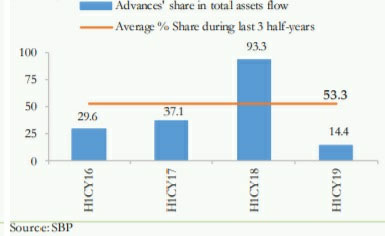Islamabad
The share of Islamic Banking Institutions (IBIs) in banking sector’s asset increased to 14.4 percent during the first half of the current calendar year, State Bank of Pakistan (SBP) reported.
According the latest report of SBP, the IBIs contribution in total assets flows during January-June 2019 was the highest in the last three years, indicating growing significance of IBIs.
However, investment (in Sukuk 3) took the lead to push the assets during the current half in contrast to previous corresponding halves when financing had played the major role, it added.
With the widespread deceleration in advances growth, the advances could only contribute 14.4 percent share in the asset growth during the period under review, lower than the average of 53.3 percent during the comparable period of last 3 years.
The demand for loanable funds weakened in both the private and public sectors, it said adding that the growth in private sector advances remained minimal during the period as compared to average expansion of 7.6 percent in the comparable period of last three years. This slowdown in private sector advances also resulted from increased risk aversion by banks, besides the seasonality.
This decline was mirrored by imports, which dropped by 17.1 percent (USD 24.5 billion in first half against US$29.6 billion during first half of 2018. The softening of aggregate demand in turn reflected in dip in growth of private sector advances. In addition, there was drop in consumer and investor confidence in the economy. On the supply side, banks became risk averse as they anticipated rise in defaults in the private sector due to hike in interest rates as well as slowdown in economic activity. Simultaneously, the increased return on risk-free securities (T-bills and PIBs), due to monetary tightening, made investment in such securities attractive for the banks in second quarter of this year .
In this backdrop, the shift in demand for and supply of advances reinforced the slowdown, the report added. Dissecting the demand of the private sector, the sector-wise flow of advances during the first half indicated a broad based reduction. Significant retirement was made by the textiles, more than their usual seasonal trend, the report added.—APP









